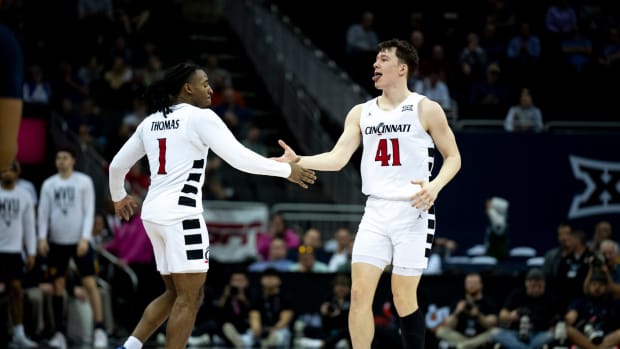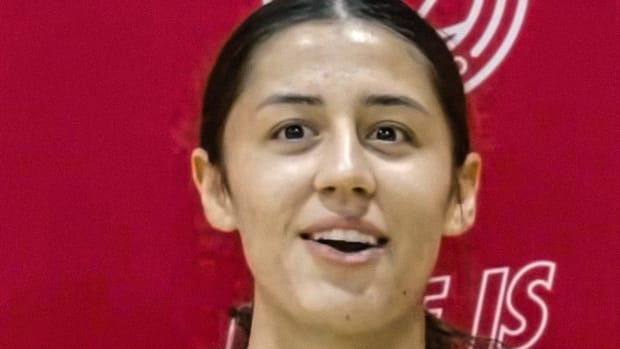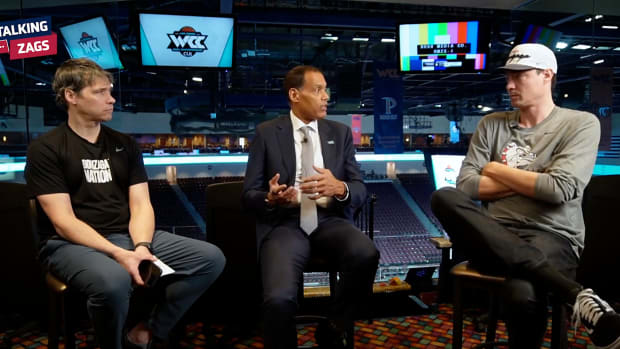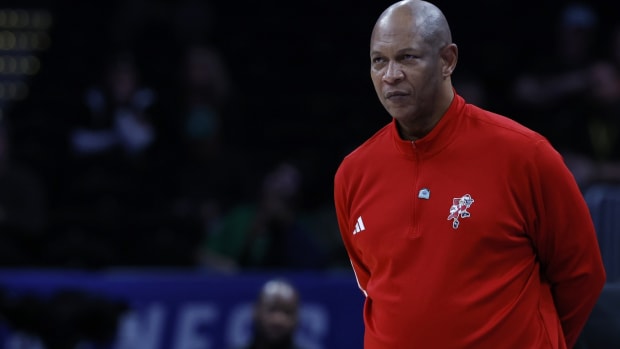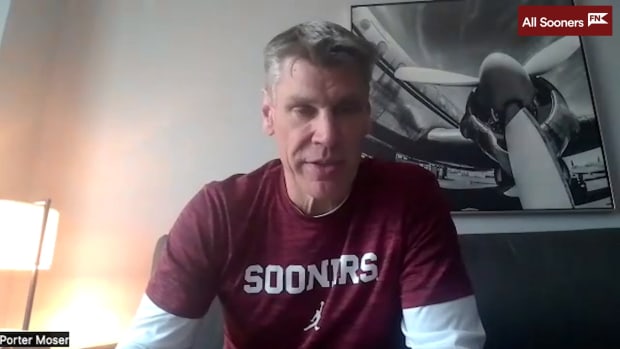The Magic Eight: One of These Teams Will Win the 2021 Men's NCAA Tournament
A year ago we rolled out the annual version of Sports Illustrated’s Magic Eight—a pool of eight teams from which that spring’s men’s national title winner will come—but for the first time since its inception, there was no outcome. The NCAA tournaments were canceled, leaving everyone to wonder what would’ve been, and the Magic Eight with no way to be validated or not. So I’m back this year with another try.
For all the madness of March, the last few champs actually haven’t been all that dramatic. A No. 1 seed has won the last three national titles, and four of the last five (the other was a No. 2 seed). In fact, since 2000, 14 of 20 champs have been a No. 1 seed, and 19 of 20 have been a No. 1, 2 or 3 seed (the lone exception was 2013–14 UConn, a No. 7 seed that broke several “rules” on what the profile of a modern champ looks like.
Nevertheless, there are indeed “rules,” and these rules hold up a vast majority of the time. This century, a men’s national champ is generally elite on at least one end of the floor (while being no slouch on the other), not overly reliant on the three (unless you’re 2017–18 Villanova) and strong on the interior defensively. This year two teams have clearly earned the status of cream of the crop (more on them below). But they wouldn’t be the first heavy favorites to stumble under the Big Dance’s bright lights.
The Magic Eight has rules as well. At least two of the top eight teams in the current men’s AP Top 25 poll must be excluded, and at least one selection must come from outside the poll’s top 15. After all, what are predictions without a little spice?
All stats and rankings are as of Thursday, Feb. 11, 2021
Gonzaga (17–0, 8–0 WCC)
No surprise here. The undefeated Zags are in position to run the table heading into March Madness, at which point they may be the tournament’s No. 1 overall seed. This team features a juggernaut offense that doesn’t rely on any one player—four Bulldogs average at least 11 points per game, led by All-America candidates Corey Kispert (20.2 ppg) and Drew Timme (18.7 ppg). Dynamic freshman Jalen Suggs, junior Joel Ayayi and sixth man Andrew Nembard are all a handful in the backcourt, while emerging 6' 8" sophomore Anton Watson provides depth in the frontcourt.
Mark Few’s go-to rotation doesn’t run deep, but it contains so many offensive weapons it can throw at opponents that it often doesn’t matter. When Gonzaga has the ball, it scores with ruthless speed and efficiency; per KenPom, it’s third nationally for the shortest average offensive possession length. As deadly as it is in transition, it’s even better in the half court, ranking first nationally in points per possession in those situations, according to Synergy Sports data. The Bulldogs don’t often try to beat you from the outside, but they can (see their 13-of-26 performance from three against Iowa, or 10-for-20 mark against Virginia). Instead, this is a throwback offense that is currently on track for the highest two-point shooting percentage of the KenPom era (since 2001–02), making 64.3% inside the arc. The only real thing to give pause about, offensively, is that its 34.9% three-point shooting mark, while respectable, is currently the program’s worst in Few’s 22 years in Spokane.
SI COVER STORY: How Gonzaga Zagged
Despite how fickle and unpredictable the NCAA tournament can be, Gonzaga feels like a safe bet to go deep. If there’s a weakness, it’s on the defensive side—particularly if its opponent can slow down the game and limit the Zags’ offensive possessions. While its overall No. 6 rank on KenPom’s defensive efficiency is impressive, four of the five Power 5 teams it faced scored at least 1.0 point per possession, and there’s no elite shot blocker on the interior. If Few’s program finally cuts down the nets, it will likely be on the back of its offense.
Baylor (17–0 9–0 Big 12)
No surprise here, either. The Bears are the only team with a chance to usurp Gonzaga for the No. 1 overall seed in March, and they’ve been right there with Few’s program all season (unfortunately for college hoops fans everywhere, the planned meeting between the schools in December was canceled due to COVID-19 cases). Earlier this month, my colleague Pat Forde described the Bears as a team that “plays the way Joe Frazier boxed: hit them in the face 15 times and they won’t even flinch; they’ll just keep coming after you.” That’s about as apt a description as you can find for Scott Drew’s team, which has somehow gotten even better since its extremely successful 2019–20.
If there’s an edge that Baylor has on paper over its counterpart Gonzaga, it’s this: The Bears are a bit more well-rounded and consistent on the defensive end, boasting not just the No. 3 KenPom offense, but the No. 3 defense as well. Junior guard Jared Butler is a National Player of the Year candidate, and when he’s not picking your pocket or leading the Big 12 in assist rate, he’s scoring on you from all over the floor. Astoundingly, Butler is one of four main rotation players sinking at least 44% of their threes, which is why Baylor leads the nation in outside shooting. But the team’s three-point rate is only a bit higher than the D-I average, a healthy number that allows space for it to beat you in other ways even on the rare night its outside shot isn’t falling.
Above everything, the scariest thing about Baylor goes back to the way Forde described them. This group has incredible poise and never lets itself get sped up, rattled or knocked off kilter. The Bears don’t panic, and if they have an off night on the offensive end, the defense—which is led by the tenacious Davion Mitchell and Mark Vital and puts a premium on keeping the ball in front—can guide them. And if you need a spark from the bench, there’s sharpshooters Matthew Mayer and Adam Flagler or center Jonathan Tchamwa Tchatchoua to provide it. Right now, the only real question about Baylor is how it will respond after its second COVID-19 pause of the season—and how many games it will need to squeeze in between its Feb. 20 return date and the start of the postseason.
Michigan (13–1, 8–1 Big Ten)
The Wolverines haven’t played since Jan. 22 due to a COVID-19-related university athletics pause, but up till that point, they’d looked stronger than pretty much anyone not named Baylor or Gonzaga. In fact, Michigan is the only team to join the two titans in the top 10 of both KenPom’s offensive and defensive efficiency rankings, making them a tantalizing option to anyone looking for an alternative champ pick in their bracket pool. Crucially, the Wolverines are also top-10 nationally in both two-point offense and defense, and can reliably shoot the ball from deep as well. This team checks a lot of boxes for the profile of a typical champ, though it’s structured somewhat differently. In March, you typically think of guard play rising to the top, but Michigan’s biggest strengths are on the interior. Mike Smith has done an admirable job taking the reins of a Big Ten offense after four years in the Ivy League, but the 5' 11" point guard is the team’s sixth-leading scorer and not exactly a likely candidate to take over NCAA tournament games in crunch time.
Instead, for offensive production the Wolverines largely rely on their wings and big men—namely 6' 7" Isaiah Livers, 6' 9" Franz Wagner and 7' 1" freshman Hunter Dickson, the last of whom is the team’s leading scorer (15.1 ppg) but had appeared to hit a bit of an offensive wall in the games directly before the pause. Getting Dickinson back on track will be one of the top priorities for Michigan upon its return, as will navigating what remains a tricky Big Ten schedule—plus whatever makeups the conference chooses to schedule.
The Wolverines are probably due for a bit of regression, and it won’t be surprising if they, like many teams who have had their seasons interrupted, come back rusty. Their five Quad 1 games are fewer than half of what fellow Big Ten contenders Illinois and Ohio State have played, so this team still has plenty to prove. And then there’s Juwan Howard, who has done an impressive job in Year 2 already to have built a national title contender in Ann Arbor, but will be attempting to join Kevin Ollie as the only coaches this century to cut down the nets in their first NCAA tournament. It won’t be easy, but Michigan’s first 14 games were too strong to leave them off here.
Illinois (13–5, 9–3 Big Ten)
With five losses, the Illini’s record may not scream “national champion” to you right now. But consider that they’ve played one of the nation’s toughest schedules, and only one of those losses (Maryland) came to a team not in the current top 25 of the NET rankings. They’ve risen from 17th on KenPom to start the season all the way to No. 4, boasting a top-10 offense and top-15 defense. They have two of the country’s top players in Ayo Dosunmu and Kofi Cockburn, a punishing inside-out duo who combine to average 38.4 points and 16.8 rebounds. They can throw two big men at you on the floor together in 7' 0" Cockburn and 6’ 9" Giorgi Bezhanishvili, or can surround Cockburn with a smaller lineup from the likes of Dosunmu, Trent Frazier, Andre Curbelo, Da'Monte Williams and Adam Miller.
Illinois was a good team a year ago, but its ceiling was limited due to subpar shooting. It has completely transformed that weakness in 2020–21, remarkably going from ranking 235th nationally in effective field goal percentage and 310th in three-point shooting to ranking ninth and 11th in those areas, respectively, this season. Its defense isn’t a pressure one that’s going to create havoc, but it seeks to take away easy opportunities in the paint and does a pretty good job at forcing opponents into isolation ball. The Illini have earned their spot on this list, even if they (like others) face an uphill battle should Baylor (which they faced Dec. 2, getting overwhelmed in the second half to lose by 13) or Gonzaga stand in their way.
Virginia (14–3, 10–1 ACC)
The Cavaliers are a bit of a vexing case, largely due to the fact that they haven’t played a particularly difficult schedule and flopped against their one elite opponent so far, Gonzaga (which, to be fair, has made many teams look silly). They’ve won 10 of 11 since, but just one (Clemson) was against an opponent in the KenPom top 50. Ultimately, Virginia made the cut for three reasons: 1) Tony Bennett, 2) its revamped offense and 3) balance. Just six of KenPom’s current top-20 offenses are also among the top-20 defenses, and Virginia is one of them. Why is this so important? Since 2002, 11 of 18 (61%) national champs entered the NCAA tournament in the top 20 of both, and 15 of 18 (83%) entered in the top 30 of both—and, again, that’s entering the tournament, so any presumed improvement from past champs over those six tourney wins isn’t a factor.
Let’s get back to the revamped offense, though: After being putrid on that end last season, UVA has turned things around big time, thanks to the additions of transfers Sam Hauser and Trey Murphy and a larger role for 7' 1" senior center Jay Huff, one of the best shooting big men in the country. Kihei Clark is the lone starter left from the 2018–19 championship team, but he’s still running the offense, and Tomas Woldetensae provides sharpshooting potential off the bench. The Cavs’ ability to shoot, rebound their own basket and take care of the ball makes them dangerous in any matchup—and they’re on track for a top-three seed in the dance—but backers should still be careful based on the (current) lack of truly quality wins.
Ohio State (16–4, 10–4)
The Buckeyes have one of the most impressive résumés in the country, including more Quad 1 wins (eight) than anyone. While they’ve come on a bit late to the title contender conversation, it would be remiss to exclude a team with that combination of body of work and shot at a No. 1 seed (remember: 14 of the last 20 champs have been a No. 1). The offense is what stands out here—No. 4 on KenPom, it’s led by guard Duane Washington Jr. and forward E.J. Lidell, who might not be Dosunmu–Cockburn but are a pretty darn good duo in their own right. Justin Ahrens, meanwhile, is hitting 48% of his threes, and senior Kyle Young continues to be a glue guy who does a little bit of everything.
Despite all that, if Ohio State is to win the whole thing, it’s got some work to do on the defensive end. Since 2002, the lowest an eventual national champion ever entered the tournament on KenPom’s adjusted defensive efficiency ranking was No. 37, where both 2014–15 Duke and 2008–09 UNC were. The Buckeyes’ current rank is 64th, by far lower than the rest of the Magic Eight’s, and they rarely force turnovers, putting more pressure on the aforementioned offense. There is, of course, still time to improve that mark, but over the last month, Ohio State dropped eight spots (and on T-Rank, its defense since Jan. 1 ranks 59th). Regardless of what the math says, Ohio State is included because it’s earned it through its actual on-court wins.
Houston (17–2, 11–2 AAC)
The Cougars might seem like a bit of an odd choice here, and indeed there are concerns. For one thing, it’s immensely difficult for teams outside the Power 5 and Big East to win the whole thing (UConn, of course, did it out of the AAC though in 2014), and Houston’s shooting numbers are almost enough to scare you off: a No. 206 ranking in effective field goal percentage and a No. 246 mark on two-pointers. But here is the case for Kelvin Sampson’s team: For one thing, its defense is elite. It completely shuts down opponents in the half court, boasting the country’s best mark for defensive field-goal percentage in those situations. In the last tournament we had, a Texas Tech team that ranked No. 2 in the same stat rode that defense all the way to the title game. The Cougars are holding opponents to a paltry 26.9% mark from three, and their athletic guards are always a threat to force turnovers, which in turn spark the kind of offense where the team is at its best: in transition.
Offensively, Houston is led by its backcourt trio of Quentin Grimes (yes, the former Kansas guard), Marcus Sasser and DeJon Jarreau, and the three of them are a handful. While the team’s collective shooting stats do leave something to be desired, it has an ace in the hole to help mitigate it: Houston is the top offensive rebounding team in the country, grabbing 40% of its misses, thanks to senior forwards Justin Gorham and Brison Gresham. Remember what I was saying about balance? The Cougars are one of those six teams nationally in the KenPom top 20 on both ends—in fact, they’re currently among both’s top 15.
Tennessee (14–4, 7–4 SEC)
For the final spot, which must go to a team outside the current AP top 15, I’m taking a flier on a group that is still very much developing but is oozing with potential if it can put it all together over the next month and a half. The Vols had the most efficient defense in the country until playing without anchor Yves Pons on Wednesday night vs. Georgia (they’re now No. 2) and feature a suffocating half-court D that puts immense pressure on opponents (Tennessee is one of just two teams nationally in the top 15 for both defensive turnover rate and block rate, the other being VCU).
It’s the offensive side keeping this team from being viewed as a Final Four favorite right now. The Vols are 62nd nationally on KenPom and shooting just 32.1% from three in SEC play, and when they struggle on that end, they struggle (see: their recent 52–50 loss to Ole Miss). Seven different Vols are averaging between 8.9 and 11.7 points per game, which helps with balance but is essentially the problem in itself. They need more consistency out of talented freshmen Keon Johnson and Jaden Springer, and especially need more production out of senior center John Fulkerson. Johnson and Springer are showing signs of breaking out, which could change this team’s fortunes down the stretch. There’s a lot that needs to go right here, but Tennessee feels like a worthy inclusion to wrap the Magic Eight.
Notable Omissions:
Alabama (16–5, 11–1 SEC)
The Crimson Tide are a fascinating team and were perhaps the toughest one to leave off the Magic Eight. Alabama’s offense is what gets the buzz, but its defense is what stirs the drink. No. 1 on KenPom, the D has been stifling SEC opponents during its 11–1 run in the conference, including holding opposing teams to a 25% mark from three. Getting stops allows the Bama offense to, in turn, do its thing, playing in the Nate Oats “run-and-gun” style that, well, includes playing fast and hoisting a lot of threes. The Tide’s 30-point road rout of LSU in January represented the best of what this team can be: an absurd 23-for-43 performance from three and 22 fast-break points, while holding the Tigers to below 1.0 points per possession.
This Tide should be viewed as quite dangerous in March, especially when you consider they’ve been playing without center Jordan Bruner for eight games and that do-everything senior Herbert Jones has been banged up of late. Their defense has generally been consistently excellent, but the offense has been more volatile. No team in the country is more midrange-shot-averse than Alabama, which puts a premium on shots from deep and up close. That’s a smart strategy, but its current numbers at the rim pale in comparison with those of a modern champ: Since Hoop-Math started tracking in 2011–12, all 16 teams that have played in the national championship game have shot at least 60% at the rim on the season—and 15 of 16 shot at least 64%. Alabama is currently shooting 55.7% at the rim, good for 284th nationally, despite ranking 43rd in shots attempted there. Compare Alabama’s FG% at the rim to that of top contenders Gonzaga (73.9%), Michigan (72.7%) and Baylor (68.3%), and you can see the concern over the six-game gantlet that is an NCAA tournament title run.
Villanova (13–2, 8–1 Big East)
Hey, what’s the Magic Eight without some contentious decisions, right? Leaving out a Jay Wright team is ... difficult. It’s been an interesting year for ’Nova—after a 7–1 start that included a win at Texas, the team had nearly a month off for a COVID-19 pause before coming back to go 4–1 so far. The Wildcats’ offense, led by a senior point guard in Collin Gillespie, is exactly what you’d expect—very efficient, excellent perimeter shooting on a high three-point rate and a low turnover rate. It’s a team capable of running you out of the gym, as it did to Marquette on Wednesday night.
Defensively, though, something hasn’t quite clicked with this group. It lacks a deterrent in the paint—none of 6' 9" Jeremiah Robinson-Earl, 6' 9" Cole Swider or 6' 7" Jermaine Samuels is much of a shot-blocking threat—and is sub-200 nationally in both two-point and three-point defense, with a particular vulnerability in transition and on opposing spot-ups, per Synergy Sports data. The risk in leaving Villanova off—and I acknowledge there’s certainly a risk—is that it very likely hasn’t hit its ceiling yet. But in the end, it lacks the level of wins of a team (Ohio State) with a similar defensive efficiency ranking, and, in an erratic year, I’m opting for the higher-quality résumé.
Iowa (14–6, 8–5 Big Ten)
Despite their recent slide, the Hawkeyes have an impressive team—No. 5 on KenPom, experienced, battle-tested, deep and featuring both Luka Garza and overall offensive firepower that rivals Gonzaga’s. And it’s notable that sharpshooting guard CJ Fredrick missed three of their last four losses. But regardless of current form, Iowa isn’t in the Magic Eight for one simple reason: Its defense currently checks in at No. 120 on KenPom’s efficiency rankings.
This was a big concern for Iowa heading into the season, as last year its very similar roster finished 97th, and it’s been five seasons since a Fran McCaffery team finished within the top 90. The Hawkeyes’ offense has gotten even better this year, but its defense remains a limitation—while it’s much-improved inside the arc, it ranks sub-200 nationally in three-point defense, defensive rebounding, steal percentage and defensive turnover rate, and is particularly susceptible in transition. Again, no national champion in the KenPom era has ever entered the tournament ranked worse than 37th defensively. Iowa has a long, highly unlikely road to get there—or else it needs to completely break the mold on the back of its offense.
Texas (12–5, 6–4 Big 12)
It’s hard to know exactly what to make of the Longhorns’ recent slide. After starting the season 10–1, they’ve lost four of six, the lone wins both coming against a dismal Kansas State squad. During that span, Texas has dealt with COVID-19 issues that included canceled games, coach Shaka Smart and multiple starters’ missing at least one game, and lost valuable practice time as others were held out due to contact tracing. While it’s tempting to give the Longhorns a total mulligan for the last month, it’s easier said than done to simply assume they will get back to the form they were in in the first half of the season.
The biggest issue has been Texas’s drop-off defensively, which has lasted nearly a month and a half. From opening night until its Jan. 2 shellacking of Kansas, it was holding opponents to 42.3% shooting from two and 24.8% from three. Since then, opponents have shot 47% from two and 36.3% from three. Some of that is absolutely due to the roster and schedule interruptions, but given the uncertainty and negative trend, I’m staying away.
Missouri (13–4, 6–4 SEC)
The Tigers have been one of the surprises of the season, climbing all the way to No. 10 in the current AP poll. Even before Wednesday night’s blowout loss to Ole Miss put a damper on that, under the hood, that ranking looked inflated: They average out to No. 40 on five college hoops analytics sites (KenPom, T-Rank, ESPN BPI, Sagarin and Haslametrics). This is a tough, veteran group that features several capable scorers (namely Xavier Pinson, Dru Smith and Jeremiah Tilmon) and owns wins over Illinois, Tennessee and Alabama. But weak perimeter shooting (291st nationally at 30.7%) and a recent propensity to struggle to close out games are both Achilles’ heels that make it tough to envision Mizzou going all the way.
West Virginia (14–5, 7–3 Big 12)
The Mountaineers are rounding into form at a good time. Were they 16th instead of 14th in this week’s AP poll, they likely would’ve made the cut as the sub-15 team. Alas, there’s not quite enough here to justify putting them above some of the other contenders. West Virginia has adapted well after the midseason transfer of big man Oscar Tshiebwe, and it’s critically starting to find more consistent scoring outside guard Miles McBride and center Derek Culver. This isn’t Press Virginia—in fact, this iteration of WVU is just O.K. defensively, and isn’t the menace in the paint as some of Bob Huggins’s teams in the past. It continues to improve offensively, currently ranking 10th on KenPom on that end, but is hindered by poor shooting inside the arc (including ranking last in Big 12 play). If it lands on the 4–5 seed line, it could be a tricky climb out of the region.
Texas Tech (14–6, 6–5 Big 12)
The Red Raiders are No. 7 in the AP poll despite a 6–5 conference record, which speaks to how spread out their losses are. This isn’t quite a vintage Chris Beard defense, as Texas Tech’s three-point D in particular has fallen off a cliff (Big 12 teams are shooting a whopping 41.3%, which is likely partly bad luck). Mac McClung has fit into Lubbock like a glove, but the Red Raiders lack a true sharpshooter (Kyler Edwards is the only player above 35% from three) and are just 4–5 in Quad 1 games. A solid squad with potential to go deep, but likely not a national champ.
Florida State (10–3, 6–2 ACC)
The Seminoles were given serious consideration for the spot outside the AP top 15. The length, physicality and acumen of Leonard Hamilton’s FSU teams have given them a recent history of success in March, even if he’s never won it all. This is another big and athletic Florida State team. It can shoot both inside and outside the arc and features a likely NBA lottery pick in Scottie Barnes, a 6’ 9” playmaker who is third in ACC play in assist rate. But the Seminoles have played only 13 games so far, and it’s hard to get a full gauge on their ceiling.
Virginia Tech (14–4, 8–3 ACC)
Mike Young has done a commendable job in Blacksburg to get the Hokies to a top-20 ranking in Year 2, and Keve Aluma has been a revelation, but a national title in 2021 seems a bridge too far. Virginia Tech checks in at No. 34 on KenPom, with neither its offense nor defense ranking higher than 36th. While time remains to improve that, every champ in the KenPom era has entered the tournament within the top 21 on at least one end.
USC (16–3, 10–2 Pac-12)
The Trojans are quietly emerging as perhaps the class of the Pac-12. Winners of 11 of their last 12, they make their bones on the defensive end, especially inside the paint. USC is holding opponents to just 41.5% shooting for two, good for fourth nationally, thanks to the defensive anchor of 7-footer (and potential No. 1 NBA draft pick ) Evan Mobley. The Trojans have a nice profile, but they lack a top-30 KenPom win, and No. 27 BYU is their only such win in the NET. They also lack a true perimeter threat (Drew Peterson, at 38%, is their best three-point shooter, but on only 50 attempts) and struggle as a team at the free throw line. USC’s best chance is to keep piling up wins, play itself into a top-three seed and ride its defense to a deep run in March.
Oklahoma (12–5, 7–4 Big 12)
The Sooners have been one of the biggest risers since mid-January. They’re similar to Virginia Tech in that they’re solid on both ends but not particularly elite on either, which lines up pretty well with their 4–5 mark in Quad 1 games. Oklahoma takes great care of the ball, which has helped offset its 31.9% three-point shooting in Big 12 play (however, junior Umoja Gibson has been a bright spot at 44.3% from deep). In its favor, Lon Kruger’s team has played itself into contention for a No. 3 seed, and getting out of the 4/5 line would be a big boost—but it’s going to take more wins.
Creighton (15–5, 11–4 Big East)
The Bluejays are a perfectly solid team, particularly on the offensive end—where they’re not quite as explosive as they were a season ago, but still plenty dangerous. Creighton is also much more than just Marcus Zegarowski; in fact, five Bluejays average double figures. Greg McDermott starts three seniors and two juniors, which will make for one of the tournament’s most experienced units. But Creighton is just a No. 6 seed in both SI’s latest projection and the Bracket Matrix, and unless it sweeps Villanova this month, its realistic best-case scenario feels like the Elite Eight.
Wisconsin (15–6, 9–5 Big Ten)
The Badgers have been a bit of a disappointment this season—at least as much as they can be while still being a top 10–20 team on virtually every college hoops analytics list. They were a very tempting option to pick as the team outside the AP top 15, but ultimately it came down to this: Wisconsin has had its chances this season against the elite, and it’s 3–4 in Quad 1 games. The hot three-point shooting that carried it to the Big Ten title last season and to an 8–1 mark to start this year has dissipated; since Dec. 28 it’s shot just 32% from deep and gone 7–5. As experienced and talented as this team is, it’s difficult to trust one whose ceiling seems to vacillate so widely depending on whether the outside shots are falling.
Loyola Chicago (17–3, 12–1 Missouri Valley)
Yes, the Ramblers get a mention here. Don’t look now, but they head into this weekend’s big double-showdown with Drake ranked 15th on KenPom and 12th in the NET. They seem destined to be well underseeded this March, and center Cameron Krutwig is playing like an All-American, but they’d face a steep climb to actually cut down the nets on April 5. Then again, they do have Sister Jean on their side.

